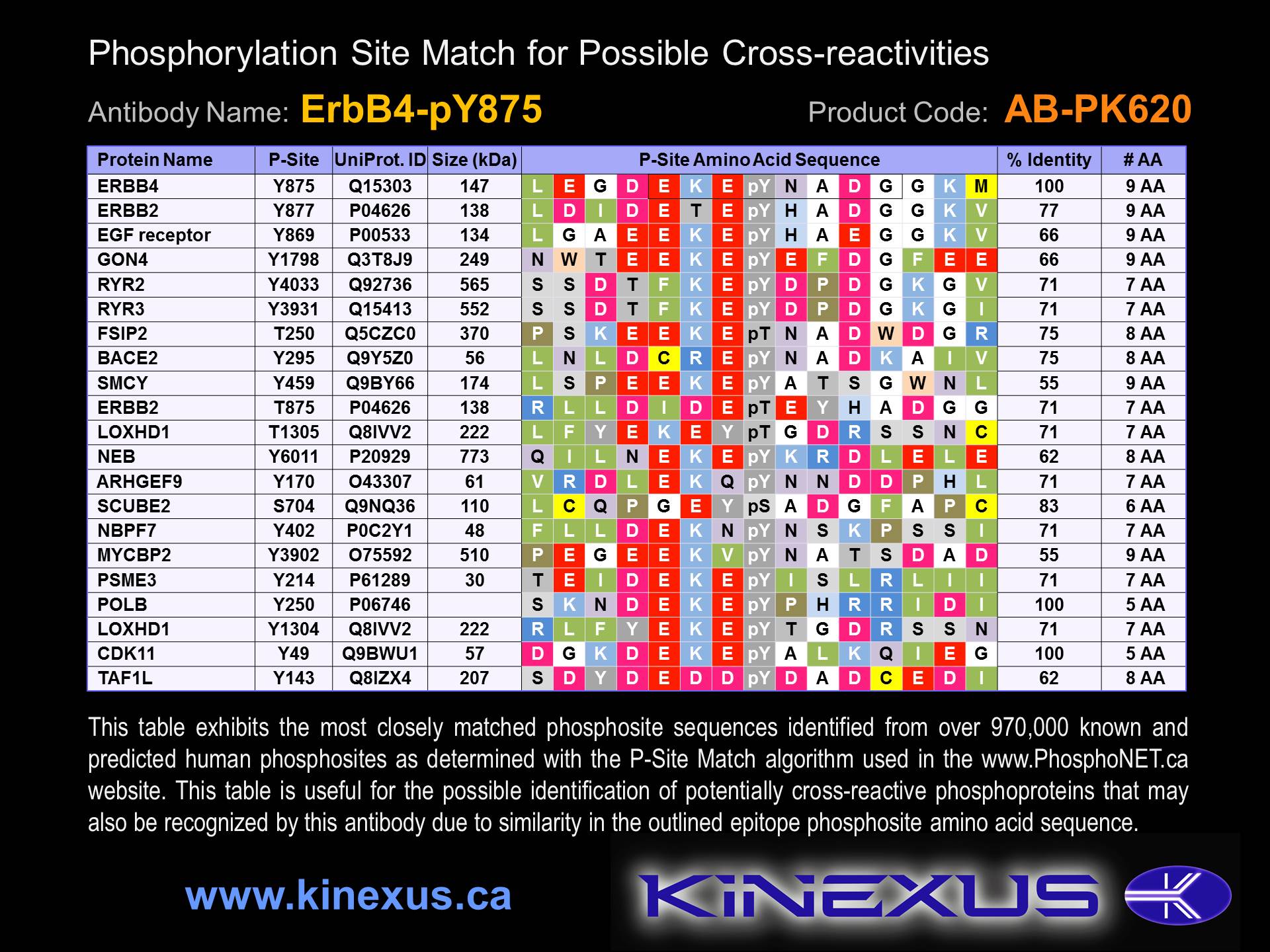Product Name: ErbB4-pY875
Product Number: AB-PK620
| Size: | 25 µg | Price: | 89.00 | |
| $US |
Target Full Name: ErbB4 receptor-tyrosine kinase
Target Alias: HER4; Kinase ErbB4; P180erbB4; P180-erbB4; V-erb-a erythroblastic leukemia viral oncogene 4; MGC138404; CCDS2394.1; ENSG00000178568
Product Type Specific: Protein kinase phosphosite-specific antibody
Antibody Code: PK620
Antibody Target Type: Phosphosite-specific
Antibody Phosphosite: Y875
Protein UniProt: Q15303
Protein SigNET: Q15303
Antibody Type: Polyclonal
Antibody Host Species: Rabbit
Target Alias: HER4; Kinase ErbB4; P180erbB4; P180-erbB4; V-erb-a erythroblastic leukemia viral oncogene 4; MGC138404; CCDS2394.1; ENSG00000178568
Product Type Specific: Protein kinase phosphosite-specific antibody
Antibody Code: PK620
Antibody Target Type: Phosphosite-specific
Antibody Phosphosite: Y875
Protein UniProt: Q15303
Protein SigNET: Q15303
Antibody Type: Polyclonal
Antibody Host Species: Rabbit
Antibody Immunogen Source: Human ErbB4 (HER4) sequence peptide
Antibody Immunogen Sequence: EKE(pY)NADG(bA)C
Antibody Immunogen Description: Corresponds to amino acid residues E872 to G879; In protein kinase catalytic domain activation T-loop between subdomains VII and VIII. This is the major in vivo phosphorylation site in ErbB4.
Antibody Immunogen Sequence: EKE(pY)NADG(bA)C
Antibody Immunogen Description: Corresponds to amino acid residues E872 to G879; In protein kinase catalytic domain activation T-loop between subdomains VII and VIII. This is the major in vivo phosphorylation site in ErbB4.
Production Method: The immunizing peptide was produced by solid phase synthesis on a multipep peptide synthesizer and purified by reverse-phase hplc chromatography. Purity was assessed by analytical hplc and the amino acid sequence confirmed by mass spectrometry analysis. This peptide was coupled to KLH prior to immunization into rabbits. New Zealand White rabbits were subcutaneously injected with KLH-coupled immunizing peptide every 4 weeks for 4 months. The sera from these animals was applied onto an agarose column to which the immunogen peptide was thio-linked. Antibody was eluted from the column with 0.1 M glycine, pH 2.5. Subsequently, the antibody solution was neutralized to pH 7.0 with saturated Tris.This antibody was also subject to negative purification over phosphotyrosine-agarose.
Antibody Modification: Unconjugated. Contact KInexus if you are interest in having the antibody biotinylated or coupled with fluorescent dyes.
Antibody Modification: Unconjugated. Contact KInexus if you are interest in having the antibody biotinylated or coupled with fluorescent dyes.
Antibody Concentration: 0.07 mg/ml
Storage Buffer: Phosphate buffered saline pH 7.4, 0.05% Thimerasol
Storage Conditions: For long term storage, keep frozen at -40°C or lower. Stock solution can be kept at +4°C for more than 3 months. Avoid repeated freeze-thaw cycles.
Product Use: Western blotting | Antibody microarray
Antibody Dilution Recommended: 2 µg/ml for immunoblotting
Antibody Potency: Strong immunoreactivity of a target-sized protein by Western blotting in A431 cells.
Antibody Species Reactivity: Human
Antibody Positive Control: The observed molecular mass of the processed target protein on SDS-PAGE gels is reported to be around 150-170 kDa.
Storage Buffer: Phosphate buffered saline pH 7.4, 0.05% Thimerasol
Storage Conditions: For long term storage, keep frozen at -40°C or lower. Stock solution can be kept at +4°C for more than 3 months. Avoid repeated freeze-thaw cycles.
Product Use: Western blotting | Antibody microarray
Antibody Dilution Recommended: 2 µg/ml for immunoblotting
Antibody Potency: Strong immunoreactivity of a target-sized protein by Western blotting in A431 cells.
Antibody Species Reactivity: Human
Antibody Positive Control: The observed molecular mass of the processed target protein on SDS-PAGE gels is reported to be around 150-170 kDa.
Antibody Specificity: High-very high
Antibody Cross Reactivity: No immunoreactivity on protein dot blots with recombinant human ErbB2. No significant cross-reactive proteins detected in A431, MCF7 and HeLa cells.
Related Product 1: ErbB4 pan-specific antibody (Cat. No.: AB-NK235)
Related Product 2: ErbB4-1 pan-specific antibody (Cat. No.: AB-NK235-1)
Related Product 3: ErbB4-2 pan-specific antibody (Cat. No.: AB-NK235-2)
Related Product 4: ErbB4-3 pan-specific antibody (Cat. No.: AB-NK235-3)
Related Product 5: ErbB4-pY733 phosphosite-specific antibody (Cat. No.: AB-PK619)
Antibody Cross Reactivity: No immunoreactivity on protein dot blots with recombinant human ErbB2. No significant cross-reactive proteins detected in A431, MCF7 and HeLa cells.
Related Product 1: ErbB4 pan-specific antibody (Cat. No.: AB-NK235)
Related Product 2: ErbB4-1 pan-specific antibody (Cat. No.: AB-NK235-1)
Related Product 3: ErbB4-2 pan-specific antibody (Cat. No.: AB-NK235-2)
Related Product 4: ErbB4-3 pan-specific antibody (Cat. No.: AB-NK235-3)
Related Product 5: ErbB4-pY733 phosphosite-specific antibody (Cat. No.: AB-PK619)
Scientific Background: ErbB4 (HER4) is a protein-tyrosine kinase of the TK group and EGFR family. It is a receptor kinase that upon binding ligands such as neuregulins can drive signalling cascades and many cellular responses to change gene expression, cytoskeletal rearrangement, anti-apoptosis and increased cell proliferation. Phosphorylation at Y1056 induces interaction with PIK3C2A, and phosphorylation at Y188 induces interaction with Shc1. ErbB4 is a known oncoprotein (OP) and tumour suppressor protein (TSP). Downregulation of ErbB4 has been described in bladder cancer to correlated with oncogensis, but its upregulation is noted in lung cancer. Its mutation pattern in human tumours is very characteristic of a tumour suppressor protein. Mutations in ErbB4 are associated with many types of cancer. Multiple missense mutations in ErbB4 have been found in melanoma patients with increased ErbB4 phosphotransferase activity and transformation ability. Melanoma cells with mutant ErbB4 had reduced cell growth after shRNA knockdown of ErbB4 or treatment with ErbB inhibitor.
© Kinexus Bioinformatics Corporation 2017


